
SALTO – 5 months old

7 months old

9 months old

13 months old
I – first moult
The most important moult occurs during infancy, between four and seven months of life.
Some will moult for the first time between 11 and 14 months.
It is also possible that the puppy does these two moults.
During this period, puppies can lose almost all their hair. They are said to have a ‘monkey face’.
Don’t panic, this is a natural process and the fur will grow back even more beautiful.
From the age of 8 months onwards, the fur begins to fill in with its adult coat.
Others have a progressive moult. The puppy’s hair falls out at the same time as the adult hair grows. His coat will therefore change without the puppy undergoing a major moult. This is what happened at home for SATI and TAO.
Let’s take Sia’s and Saphir’s moult

SIA – 3,5 months old

4 months old
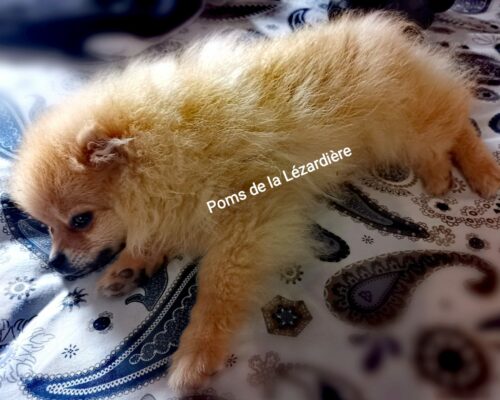
4,5 months old

SAPHIR – 3,5 months old

4 months old
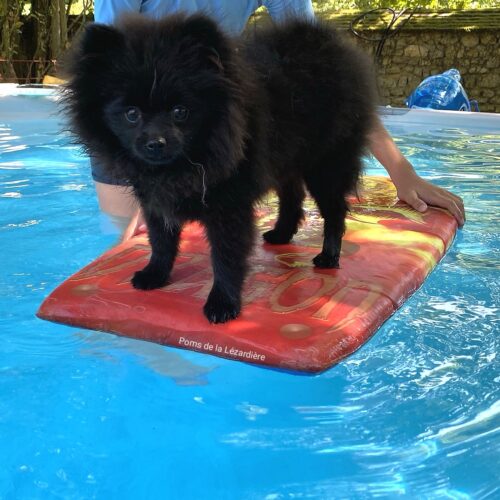
4,5 months old

SIA – 5,5 months old

6 months old

7 months old

SAPHIR – 5 months old
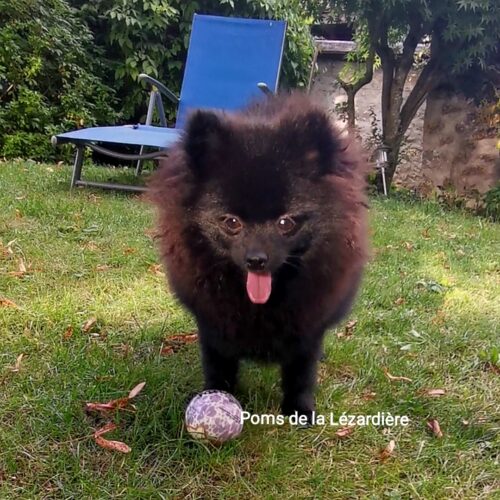
6 months old

7 months old

SIA – 8 months old

9 months old

10 months old

SAPHIR – 8 months old

9 months old

10 months old
The purpose of this intense moult is to replace the puppy’s coat with that of the adult.
In addition to hair loss, some puppies may show a change in coat colour. This is more common in orange, tan and brown miniature spitzes, where the change in colour is easier to notice.
Let’s take the moult of Pom, a charcoal orange male

POM – 6 months old


POM – 36 months old
Daily thorough brushing is necessary to remove dead hair.
His coat continues to grow and develop until the end of his second year.
The puppy coat and the adult coat
What is the difference between a puppy coat and an adult coat?
Puppies are born with a single layer of soft, fluffy fur that helps regulate their body temperature. This coat naturally gives way to their adult coat, which is usually thicker and stiffer than their puppy’s.
As they develop, double-coated breeds develop two layers of adult fur, with the undercoat usually shorter than the outer coat. Single-coated dog breeds develop their own distinctive coats as they shed their puppy coats – some short and curly and others long and silky.
Some changes in appearance are normal during this phase. Dogs can develop coats that are a different colour to their puppy. Dalmatians are known for this, as they are born without spots, but many breeds develop different coat colours and patterns when they shed their puppy coat. English Setters, Bedlington Terriers, Kerry Blue Terriers and Shih Tzu are some of the breeds that can change colour dramatically from puppy to adult.
When do puppies shed their coats?
Puppies shed their coats between 4 and 6 months of age, although this time varies considerably from breed to breed and canstart at 12 weeks or wait until they are a year old. You may not notice your puppy shedding, especially if it is a short-haired breed, or the change could be dramatic. Some long-haired breeds go through a few difficult months known as “the uglies” and may look a little dishevelled, patchy or shaggy when their adult coat arrives. Other breeds, such as the Pomeranian, may take up to 2 years to develop their full adult coat.
Many people believe that long-haired dogs, like Collies, shed more than short-haired dogs, like Labrador Retrievers. Although long hair may be more visible on your clothes or sofa, short-haired dogs often have denser coats that shed more naturally. Even breeds that do not shed will shed a small amount of hair when they are puppies, although it may take longer for this to happen.
You may be wondering if the amount of shedding your puppy does is an indication of how much he will shed as an adult. This varies – some puppies will shed very little but will start to shed a lot more as adults, and other puppies will shed more than they will as adults. As an owner, you can play an important role in helping your puppy develop a healthy adult coat.
“A complete and balanced diet that includes the proper vitamins and nutrients is important for a proper and healthy coat in dogs,” says Dr. Jerry Klein, AKC’s chief veterinarian. “Ask your vet or breeder what is the best diet for your puppy. And be sure to give her plenty of fresh, clean water, as dehydration can lead to hair loss.
Grooming your puppy’s changing coat
Regular grooming is an essential part of any dog’s care and is especially important as your dog’s coat grows from puppy to adult. Grooming is a great bonding experience for you and your dog, and it also ensures that he is comfortable being handled all over his body. This is especially important for puppies with longer coats, as regular grooming is necessary for their health and your sanity.
Good grooming is also important to ensure that your dog’s adult coat is healthy. If you plan to take your puppy to a professional groomer, it’s a good idea to start when he’s young. Look for a groomer you can trust to be gentle and patient.
There are a variety of types of dog brushes – bristle, wire, smooth – and it’s important to use the type that best suits your puppy’s coat type. A puppy’s coat often requires a softer brush than an adult’s, so ask your breeder, groomer or vet to suggest the best type of brush to use.
You want to get your puppy used to being brushed from the start – so be gentle and patient, give him a chance to sniff the brush, offer him a puppy toy to chew on while you brush him and reward him with a treat when you finish. In addition to brushing, bathing your dog also helps to remove dead hair. Make sure you use an anti-weep shampoo that doesn’t irritate her eyes.
Abnormal hair loss and shedding in puppies
Hair loss in puppies is normal, but not all hair loss is healthy. “Take your puppy in for a full examination if he has exceptional hair loss or any of the symptoms listed here,” says Dr Klein.
- Bare patches of skin
- Scaly skin
- Red or inflamed skin
- Loss of large patches of fur
- Excessive scraping
These are symptoms of a condition called alopecia and can be caused by a wider problem, such as fleas, ticks, mites, fungal or bacterial infections, medical conditions such as Cushing’s disease or inflammatory bowel disease, hormonal imbalance, poor diet or stress. All these conditions require diagnosis and treatment by a veterinarian.
The time you spend raising a puppy is filled with excitement, fun, dedication and sometimes worry. Your puppy’s coat doesn’t have to be a problem. With regular grooming and the right knowledge, you and your puppy can make the transition from puppy to adult together – even if your puppy develops a case of the “ugly” along the way.
Reference : akc.org – American Kennel Club
II – Seasonal moults
The coat of the spitz is characterized by the presence of two types of hair called complex coat (double coat). There are long hairs, the topcoat, and a soft woolly undercoat, the down.
A dog’s hair grows, dies, falls out and is constantly renewed.
Molting is a more extensive loss of hair than usual.
The moult has a thermoregulatory role.
It is especially pronounced in spring and autumn when there are major changes in temperature and sunlight. It lasts about 3 weeks.
These are the two climatic phenomena that trigger moulting in your dog.
1- The spring moult is more important. The topcoat protects against the sun’s rays while the fuzz dies and falls out, allowing the skin to breathe better. The dog will be less hot during the summer.
Indeed, in order to protect itself in winter, the dog’s coat density increases in autumn.
2- The autumn moult is less important. The thicker winter coat is coming on. The blanket hair protects from the rain and the thick down protects from the cold. The dog will be better equipped to face the sometimes harsh winter weather conditions.
Don’t forget that brushing also acts on the regeneration of the hair.
III – Postpartum moult
Let’s take the moult of mother Plum after the birth of her 5 puppies.

Prune – 1 month later
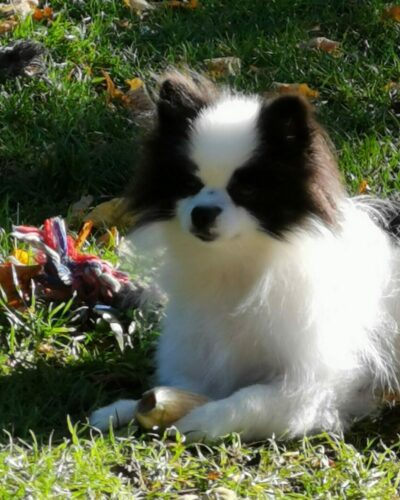
4 months later
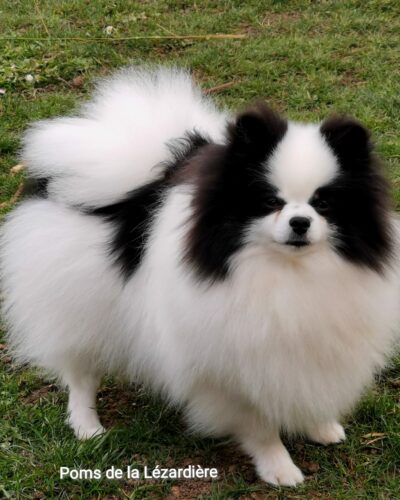
8 months later
It is not uncommon for a bitch to shed a lot of hair after giving birth or when nursing her puppies. This is called telogen effluvium.
Cause
Hair grows in cycles: there is a growth phase, or anagen; a phase when the hair stops growing, catagen; and a rest phase, telogen.
Different areas of a dog’s coat may not be in the same phase of hair growth. Due to the stress of whelping and nursing, the hair can enter the resting phase, so it can all fall out at the same time. Hormonal changes can also affect hair loss.
Symptoms
Dogs can shed their hair in large clumps, which can leave some areas completely hairless. The skin usually appears quite normal. Hair loss usually occurs symmetrically on the back, sides and flanks.
This can happen up to three months after giving birth. Hair that falls out can become matted and provide a breeding ground for bacteria or other micro-organisms that can cause skin infections.
Traitement
Brushing the dog’s coat regularly will help remove trapped hair and prevent the coat from becoming knotted.
This will also help speed up the shedding process and reduce the amount of hair that falls out in the house.
A pregnant or nursing bitch should be fed a diet that meets her special needs. Vitamin supplements can be prescribed by your vet which will help reduce hair loss.
Considerations
A blown coat will grow back. It may not look like the coat that fell off, but it will grow back after a few months. The new coat may appear darker and thinner, which may also give the impression that the dog is shedding more hair than it actually is. The hair may have a different texture to that of the fallen hair. In dogs with a top coat and undercoat, shedding may be more pronounced.
Warnings
Excessive loss can also be caused by extreme stress. If hair loss persists for more than three months after giving birth, it may be due to other factors. Check with your vet to ensure that your dog’s hair loss is not related to anything other than reproduction and lactation.
Always consult your veterinarian before changing your pet’s diet, medication or physical activities. This information does not replace the advice of a veterinarian.
Reference : Cuteness.com – by Colleen O’Brien
The dog’s hair
Here is an article on dog hairthat I find interesting.
I advise you to consult the dog.com website
which explains:
1. What is the purpose of a dog’s coat?
2. The structure of the dog’s coat
3. The structure of the dog’s skin
4. The growth cycle of the dog’s hair
5. Coat types in dogs
6. The colour of the dog’s coat
7. Coat changes over time
8. The moulting of the dog’s hair
9. The beauty of the coat reflects the health of the dog


